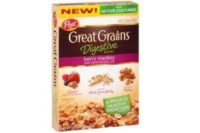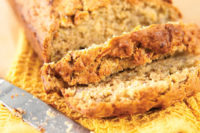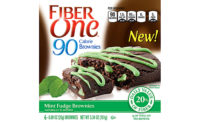Formulating with Fibers for Fitness and Functionality

The American Dietetic Association recommends consuming between 20-35g of dietary fiber per day, but currently in the U.S., only 15g is typically consumed on a daily basis. “Fiber in the diet promotes bulking, due to its swelling capability, stimulating peristaltic of intestines. Fiber contains zero calories and influences bowel function by water binding. Increased stool weight has a beneficial influence on constipation and a positive effect on colon cancer,” stated Bruce Gubser, technical sales manager, Herbstreith & Fox Inc., during his presentation, “Fruit Fiber Nutrition and Functionality,” at the 2009 Prepared Foods’ R&D Applications Seminar-Chicago.
Fruit fiber ingredients under discussion include the fiber-rich parts of fruits and vegetables or the cell wall materials. The fiber content of these ingredients can vary between 55-75%; other substances, such as differing amounts of the plant’s own sugars, starches, proteins or lipids, can also be present, depending upon the raw material. Secondary plant substances, such as polyphenols, carotenoids or anthocyanins, may also be present. As a result, “The fibers can also contain characteristic properties of the fruits or vegetable sources, such as color or flavor,” added Gubser.
Available in different particle sizes, the mostly insoluble fibers can be derived from and thus contain characteristics of apple, soybean, orange, linseed or black currant. Gubser also noted that secondary plant substances, such as flavonoids, have anti-inflammatory properties and offer other nutritional benefits, including: strengthening capillary resistance; preventing oxidation of LDL cholesterol; promoting chelation of metal ions; preventing oxidation of ascorbic acid; and inhibiting aldose reductase, linked to cataracts in diabetics.
According to Gubser, citrus (e.g., lemons or limes) fiber extraction begins with the separation of the juice and oil from the fruit. Once this is done, the insoluble plant cell wall material is dried, sieved and passed through a metal detector before being milled and sieved again. An additional washing and drying step can further increase dietary fiber content, creating more product types. The higher fiber products contain between 80-92% fiber, depending on raw material. These ingredients have a neutral taste and smell, as compared to the previously mentioned ingredients that may possess characteristics of the original fruit.
Using a special technology, the strong water binding of the cell wall components (cellulose, hemicellulose and pectin) is maintained, and interactions with other ingredients, especially water, are improved. Higher fiber ingredients have high water-binding and retention capacity, high fecal bulking index, are cold-soaking and readily dispersible, contain thickening and stabilizing properties, and have extraordinary shear stress and heat stability. They are freeze/thaw stable, very smooth and contribute negligible calorie content, offered Gubser.
Areas of application for the higher fiber ingredients are in weight management and low-calorie products. There are also applications in meats, bakery products, ice cream, dairy, sauces and marinades. In a tomato-based sauce, for example, the fiber is easy to handle, since it is heat- and shear-stable, has no risk of clump formation, and no prior dissolving step or pre-blending is necessary. The addition of this fiber can conveniently adjust product viscosity, and its pulpy structure reduces syneresis.
These ingredients can replace high-calorie ingredients, regulate insulin response and improve product mouthfeel. Gubser recommended fruit fibers for health, taste and convenience.
“Fruit Fiber Nutrition and Functionality,” Bruce Gubser, technical sales manager at Herbstreith & Fox Inc., b.gubser@herb streith-fox.com, www.herbstreith-fox.com
--Summary by Elizabeth Mannie, Contributing Editor
Oat Fiber Formulations Considerations for Baked Goods and Snacks
New products with high-fiber claims are up in the U.S. and in Europe, according to Datamonitor. In the U.S., in order to make the nutrient content claim, “excellent source of fiber,” a product must contain a minimum of 5.0g or 20% DV of fiber per serving. A “good source of fiber” must contain at least 2.5g fiber or 10% DV per serving.
“Whole grains are also needed in the average diet; however, whole grains are not the entire answer,” explained Humberto Zamora, senior applications technologist, SunOpta Ingredients, at the 2008 Prepared Foods’ R&D Applications Seminar-Chicago, in a presentation entitled “Formulating Functional Oat Fiber in Cookies, Crackers, and Snacks.” “One serving of whole grains is generally considered to be 16g, but even consuming three servings of whole grains per day (i.e., 48g of whole grain), will not increase dietary fiber levels to meet adequate intake guidelines for fiber of 25g per day. Additionally, the typical current intake of whole grain is actually only some 0.85 servings per day.”
Proposed claims for whole grains include listing 16g whole grain per serving as an “excellent source” and between 8-16g per serving as a “good source.” Also proposed is the ability to list the number of grams of whole grain per serving, if it is less than 8g. Health claims based on authoritative statements may be made on foods that are 51 % whole grain by weight per the recommended amount customarily consumed (RACC) and minimum dietary fiber contents, depending on RACC. The required wording of the claim reads, “Diets rich in whole-grain foods and other plant foods and low in total fat, saturated fat and cholesterol may reduce the risk of heart disease and some cancers.”
When formulating products with added oat fiber, achieving the target texture depends on a number of factors including other components, such as fat, water, starch, protein, adjunct components and fiber type. Functionality of oat fiber includes breakage reduction, syneresis control, water- and oil-holding capacity, fine mouthfeel, crisp texture, resiliency and improvement in shelflife. A range of functionalities can be created, depending upon the processing conditions of the oat fibers.
Zamora explained resistance of fragile baked goods to breakage is a function of hardness or strength, as measured by the force required to break the product. Flexibility is measured as the distance the product flexes and deflects until fracture. These variables also play a critical role in sensory attributes of fragile baked goods. For example, in a pretzel and tortilla chip model, tortilla chips in jars were dropped three feet, and the 0.125-in pieces were counted. Some 47% fewer broken pieces were found in the products containing 0.84% oat fiber on a flour-weight basis. Pretzels containing 1.0% oat fiber contained 84% fewer broken pieces after shipment via UPS.
“In cookies,” added Zamora, “oat fiber controls spread, with smaller particle size and porous fibers reducing spread most; long, less-porous fibers have the least effect on spread. Proteins reduce spread, and soluble fibers, resistant starch and sugar increase spread. Emulsifiers, shortening and lower melting point fats increase spread.” High-lignin oat fibers increase crunch, while low lignin contributes to chewiness and softness. Smaller particle size promotes a friable texture.
The benefits of adding oat fiber are not only dietary fiber enrichment, but also extend to reduced breakage, texture modification, yield improvement, shelflife enhancement, calorie reduction and numerous physiological benefits.
“Formulating Functional Oat Fiber in Cookies, Crackers and Snacks,” Humberto A. Zamora, senior applications technologist, SunOpta Ingredients Group, humberto.zamora@sunopta.com, www.sunopta.com
--Summary by Elizabeth Mannie, Contributing Editor
Double-duty Fenugreek and Konjac Gum
Gums are hydrocolloids, or water-soluble macromolecules of high molecular weight that bind a large quantity of water. “Gums modify the rheology of aqueous systems to which they are added; thereby, they are beneficial as texturants and nutraceutical aids,” explained Allen Freed, CEO, Gum Technology, in a presentation titled, “Fenugreek and Konjac Gum as Texturants and Nutraceutical Aids,” at the 2008 R&D Applications Seminar-Chicago. Two gums of interest to be discussed here are fenugreek and konjac, along with their properties and uses.
Fenugreek, composed of galactomannans, originates in Canada, the Mediterranean, India and North Africa. The gum is produced by milling seed from Trigonella foenum-graeum, the fenugreek plant, which is an annual belonging to the legume family. Fenugreek has a long history of use in the human diet and has been considered self-affirmed GRAS, since 2007, as per an expert panel for fenugreek galactomannan. Full GRAS status is still pending FDA notification. According to Freed, “Fenugreek gum is all-natural and kosher, and labeled as ‘fenugreek gum.’” Fenugreek galactomannan is b-(1-4) linked mannose backbone, a-(1-6) linked galactose, in a 1:1 ratio.
One of the oldest medicinal plants, studies on fenugreek indicate it lowers the concentration of cholesterol in the liver and blood plasma and decreases the rate of hepatic synthesis of cholesterol. The incorporation of fenugreek produces a significant fall in fasting blood glucose levels and an improvement in glucose tolerance tests. Bread made with fenugreek has a low glycemic index score of 48.9 +/-4.5, as measured by Glycemic Index Laboratories in 2008. Adjunct use of fenugreek seeds improves glycemic control and decreases insulin resistance in mild type-2 diabetic patients. There is also a favorable effect seen on hypertriglyceridemia.
Fenugreek is a cold water-soluble, surface-active ingredient. Compared with other galactomannans, fenugreek hydrates and thickens faster and is more efficient at stabilizing oil-in-water emulsions. Its viscosity is similar to xanthan gum. Fenugreek is tolerant to pH extremes, medium shear, is non-gelling and exhibits pseudoplastic behavior, while adding soluble fiber. Fenugreek is 85% dietary fiber on a dry-weight basis, with at least 75% being soluble fiber. It can be used as a substitute for or adjunct to guar, LBG, tara and xanthan gums.
In gravies, sauces, soups, dressings and beverages, fenugreek adds viscosity and suspension. Baked goods benefit from increased water retention, and frozen products see improved freeze/thaw stability with added fenugreek gum.
Konjac gum is a linear polysaccharide composed of mannose and glucose. Originating in China, it is derived from the tubers of the “elephant yam” (Amorphophallus konjac). Konjac is also considered all-natural and kosher and labeled as “konjac.” According to research, konjac improves glycemic control and blood lipid profile, suggesting a therapeutic potential in the treatment of insulin resistance syndrome. It improves systolic blood pressure in diabetics, reduces serum cholesterol and increases the feeling of satiety.
Konjac is very high in viscosity (>20,000cps at 1%) and can be made thermo reversible or non-thermo reversible, by altering pH. Konjac can form a gel or a smooth-flowing solution, smoother and with shorter texture than xanthan, and its viscosity increases with heat.
Applications for konjac include pasta, where it increases elasticity and steam table shelflife. In batter coatings, konjac is a film former and binder. Replacing gluten, konjac can provide texture and elasticity in baked goods. In meat and fish analogs, konjac helps retain shape and can be non-thermo reversible.
Konjac is synergistic with kappa carrageenan, resulting in strong gels with higher melt points that can be used to replace agar in some applications, especially useful in meat analogs to bind proteins together. Combined with LBG, it does not gel, but increases viscosity. With xanthan, it forms strong elastic gels upon heating with high melt points, beneficial for microwaveable products.
“Fenugreek and Konjac Gum as Texturants and Nutraceutical Aids,” Gum Technology (R&D Laboratory), 877-GUM-TECH, info@gumtech.com, www.gumtech.com
-- Elizabeth Mannie, Contributing Editor
Novel Oligosaccharides for Immune Support
According to the International Food Information Council, in 2008, about 71% of Americans agreed that some specific foods or beverages could improve immune system function. In 2006, tracking by Zenith indicated that out of 120 new products in the first half of the year, 24% placed emphasis on their potential to strengthen the immune system. Baby Boomers, 79 million strong and with a purchasing power of $2.1 trillion, are seeking immunity-boosting foods.
Since 2002, well over 100 new products have been introduced globally containing galacto-oligosaccharides (GOS). “GOS is a galactose-based oligosaccharide whose chains can be a- or b-linked,” explained Joyce Baird, business development manager, GTC Nutrition, in a presentation titled, “Galacto-oligosaccharides, Novel Oligosaccharides for Immune Health Support.” Typical commercial ingredients are b-linked galactose chains made from lactose. GOS is a soluble fiber, as determined by AOAC Official Method 2001.02: Enzymatic/HPLC.
From 1998-2009, a number of clinical studies showed the health benefits and the mechanisms of GOS as a prebiotic fiber. Lactobacilli and Bifidobacteria ferment GOS to produce short-chain fatty acids, thereby improving the microbial balance and resisting the colonization of pathogens. GOS helps to stimulate the immune system, reduce inflammation, promote mucosal health and function, enhance laxation and increase mineral absorption, said Baird.
“GOS naturally occurs in human breast milk,” added Baird, “helping to reinforce healthy immune system function, promote digestive comfort and also enhance calcium absorption.” A study of male adults showed that 2.5g per day increased Bifidobacteria levels in the gut. In another study, improved immune cell response was indicated at 2.6g of GOS per day in elderly adults.
GOS is highly soluble, increases viscosity, is pH- and heat-stable and depresses freezing point, with application opportunities in infant formula, beverages, dairy, extruded cereals, bakery, supplements and bars. In beverages, GOS is clear in solution, has a clean flavor, is cold and hot water-soluble with low viscosity, is highly pH-stable and is synergistic with high-intensity sweeteners. In dairy, it also improves mouthfeel and depresses freezing point. GOS is an excellent humectant in baked goods, contributes to elasticity in confectionery, and has good binding properties and optimal density in supplements.
At a dose of 3g per serving of GOS (per day), Baird suggested the following structure/function claims could be made on a product: “Reinforces the Body’s Natural Defenses,” “Supports Immune System Balance,” “Shields Against Harmful Bacteria” or “Promotes the Growth of Beneficial Bacteria.”
A current product example is a peach-flavored milk beverage on the market in Norway. This product contains skim milk, water, GOS, peaches, sugar, fructose, pectin and L. rhamnosus.
“Galacto-oligosaccharides, Novel Oligosaccharides for Immune Health Support,” Joyce Baird, business development manager, GTC Nutrition, Joyce.baird@cornproducts.com
--Summary by Elizabeth Mannie, Contributing Editor
Dextrin-based Prebiotic Soluble Fiber
Fiber traditionally has been thought of as roughage, or material consumed to help food pass through the digestive tract, and as a laxative. The modern view of fiber is that it is a complex mixture of substances with different chemical and physical properties that exert different types of physiological effects. Most food gets digested in the stomach, but fiber does not.
Soluble fibers include gums, dextrin-based fibers, resistant maltodextrins, inulin and polydextrose. Insoluble fibers include resistant starches, cellulose, lignan and hemicelluloses. Prebiotics are fibers that promote the growth of beneficial bacteria, when present in the digestive tract. “The FAO recently proposed that a prebiotic be defined as a non-viable food component that confers a health benefit on a host associate, with modulation of the microbiota,” explained Chandani Perera, project coordinator for Roquette America Inc., in a presentation titled, “Dextrin-based Soluble Fiber: A Prebiotic Fiber with Functional Benefits in Beverage Systems,” given during the 2009 R&D Applications Seminar-East.
Probiotics, such as Lactobacillus spp., Eubacterium spp. and Bifidobacterium spp., promote healthy functions, such as inhibiting growth of bad bacteria, stimulating the immune system, aiding in digestion, aiding in absorption of nutrients and synthesizing vitamins. Harmful bacteria, such as Pseudomonas aeruginosa, Porteus spp., Staphylococcus spp., Veillonella spp. or Clostridium spp. can cause diarrhea, constipation, infections, liver damage, malignancies or encephalopathy. Some species of bacteria can have both beneficial and negative effects, including species of Enterococcus, Escherichia coli, Fusobacterium spp. or Bacteriodes spp.
Fermentable fiber promotes the production of short-chain fatty acids, such as acetate, propionate and butyrate, which can reduce LDL cholesterol and triglycerides, promote production of immune stimulating factors, control blood sugar levels, promote beneficial bacteria, suppress pathogens, aid in increased mineral absorption and lower colonic pH, protecting the lining from colonic polyps, noted Perera.
Dextrin-based soluble fiber is derived from starch, with excellent digestive tolerance. Consumption of up to 45g per day results in no side effects. In a 14-day study, consumption of 10g of dextrin-based soluble fiber per day resulted in the growth of Bacteroides species that produce butyric and propionic acids; and 45g per day for 35 days, increased the Lactobacilli within the gut ecosystem by one log (10-fold).
Perera explained dextrin-based soluble fiber has a low glycemic index of 25, contributes no sugars to a formulation and aids in satiety. It is easily dispersed, has high solubility and low viscosity, which allows ease of processing. Dextrin-based soluble fiber does not affect the taste of a product, but does improve mouthfeel. Application examples include an isotonic sports drink containing 4.3g fiber per serving and reduced-sugar juice beverages, with 4.7g fiber per serving.
“Dextrin-based Soluble Fiber: A Prebiotic Fiber with Functional Benefits in Beverage Systems,” by Chandani Perera, project coordinator, Roquette America Inc., chandani.perera@roquette.com
-- Elizabeth Mannie, Contributing Editor
pf
Looking for a reprint of this article?
From high-res PDFs to custom plaques, order your copy today!






